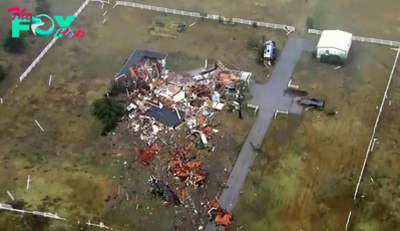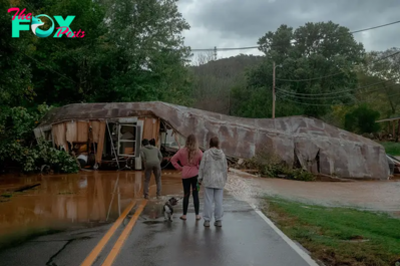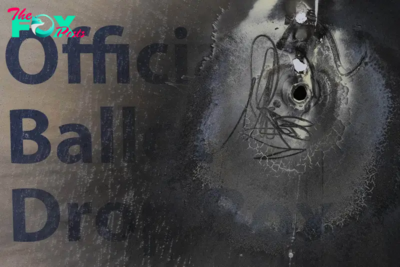US News
Snowpack in the West is melting rapidly. Where will all that extra water go?
It's getting hot out West -- and those scorching temperatures are rapidly thawing the incredible amounts of snowpack that accumulated in the mountain ranges over a very active wet season.
Now, water utility experts and environmental experts are working to ensure the freshwater running down the mountainsides won't go to waste.
The West is coming off an early season heat wave that jumpstarted a mass liquification of precipitation that fell as snow in the highest elevations in the region. As the West Coast was slammed with round after round of atmospheric rivers, it brought up to 200% more snowpack than normal to places like the Sierra Nevada mountain range.
MORE: Complications arise in the West as early heat wave causes snowpack to melt rapidly
As the snow melts, many lakes and reservoirs in the region -- which were previously drying up due to a megadrought that has plagued the region for decades -- are now overflowing, or close to it. In the past weeks, flooding was present from Washington state, down the coast and eastward toward Colorado and Utah.
The excess water is spilling away, drowning agricultural fields and washing out to sea -- a problem the region has not had to deal with in a long time.
"We really haven't been able to plan for something quite like this," David Feldman, director of Water UCI, a research center at the University of California Irvine's School of Social Ecology that studies applied water science, technology, management and policy, told ABC News.
Experts shed light on what will happen to all that extra water:
Water in overflowing rivers, reservoirs will need to be released
Reservoirs all over the West "are nearly filled to the brim," forcing water management officials to release flows downstream to prevent further flooding, Feldman said.
Once the water is released, it will hopefully flow to another reservoir downstream and can be stored for some period of time, with flow being let out when needed for irrigation or for municipal purposes, Feldman said.
But the river system in the West has been so heavily constrained -- engineered with levees surrounding the rivers and farmland right behind the levees -- that they are currently on the upper limits of flood releases, which is hindering water operations, Greg Reis, hydrologist at The Bay Institute, told ABC News. This is why there are such disastrous consequences when places like the Tulare Lake Basin or the San Joaquin River flood, destroying nearby cropland, he added.
Farmers have been diverting water from Tulare Lake, the largest hydrologic basin in California, to irrigate nearby crops since the early 1900s, Lund said, adding that an estimated 4 million feet of extra water available in the Tulare basin this year.

In the most recent floods, some farmers have been diverting the water drowning their neighbors' agricultural lands to irrigate their own, Lund said.
"We've constrained the rivers so much that a levee break could be devastating in some cases," Reis said. "So if we set those levees back with more room, we can actually evacuate more water out of our dams, reservoirs, right now and get them lower so they can absorb this pulse of slow melt that's coming."
Elsewhere in Southern California, flows have been released through the Los Angeles River, the San Gabriel River and down the Santa Clara River, Pestrella said.
There are arguments that the best solution for storage is to build more and bigger reservoirs, but that would just reinforce a system that would require releases when those reservoirs fill up, Gary Bobker, director of the rivers and delta program at The Bay Institute, told ABC News.
In extremely wet years, it may not be worth it to capture all of the water, Jay Lund, professor of civil and environmental engineering at the University of California, Davis, and the head of the school's Center for Watershed Sciences, told ABC News.
Once all the extra infrastructure is paid for, the cost of the water stored in extreme wet years could amount to several $1,000 per acre foot, Lund said. In 30% to 60% of the other years, there may be nothing additional captured at all, he added.
"At some point, it's not worthwhile capturing it all," Lund said.
MORE: California communities bracing for heavy flooding as record high temperatures melt record amounts of snow
Some communities aiming for decentralized storage of stormwater
More communities in California are aiming to create a decentralized system to store stormwater, Feldman said, adding that Los Angeles has "harvested a good deal" this past winter, as has Orange County.
In 2018, Los Angeles voters approved Measure W, which raises money through property tax assessments for building more localized storage of stormwater.
"That's still kind of in development," Feldman said. "It hasn't been fully achieved yet in Southern California or statewide."
It will cost about $1 billion and anywhere between 20 and 30 years to build the small capture system throughout Los Angeles County, Mark Pestrella, director of the Los Angeles County Public Works, told ABC News.

But that stormwater could eventually lead to making up half of the city's water demand, leading to supply resiliency and the ability sustain quality of life in Los Angeles, Pestrella said.
Homeowners in other water insecure parts of the world, most notably large cities in Australia like Sydney and Melbourne, utilize underground tanks in their yards to collect and store rainwater, Feldman said.
That solution has not been adopted in the U.S., mostly because people are unsure of what to do with that water, Feldman said. Water stored in that manner is not suitable for drinking, and states like Colorado, Utah, Nevada, Illinois and Arkansas are heavily regulated to keep homeowners from harvesting the rain that falls on their property. In Colorado, it is illegal to harvest rainwater, but each household is allowed up to 110 gallons of rain barrel storage.
The most ideal way to store rainwater is to allow the runoff to flow to reservoirs, which is already widely practiced in the West, Feldman said.
MORE: This year's 100% water allocation in California does not mean the water crisis is over, experts say
Groundwater basins will be replenished after years of overextraction
Some of the stormwater being collected by communities will be pumped back into the groundwater basins in the region, which have been heavily depleted as water supplies waned in recent years, experts said.
In parts of California, particularly the Central Valley, there has been vast amounts of water withdrawals for agricultural productivity with little replenishment from precipitation, Feldman said.
The Westlands Water District, which obtains its water through the Colorado River through the Central Valley Project, will be storing as much water as possible in the ground, Elizabeth Jonasson, public affairs representative for Westlands Water District, told ABC News.
"Overall, California does not have enough water storage," Jonasson said. The storage will be especially important with this year's 100% allocation, given in the past two years allocation through the Central Valley Project was 0%, forcing the farmers to turn to more groundwater.

Water storage and groundwater recharge will be prioritized this season, California Gov. Gavin Newsom announced in April after it was announced that communities and farmers would receive 100% water allocation for the first time since 2006.
Ensuring groundwater supplies are healthy is paramount to creating a healthy environment and robust water supply, Feldman said.
MORE: Billions of gallons of water from Lake Powell are being dumped into the Grand Canyon
The environment needs water just as much as humans, experts say
Without anywhere for the water to go, it flows out to sea via other watersheds. While not ideal in terms of water storage, the ecosystem, also thirsty from the last several decades of drought, is also in dire need of replenishing, according to environmental experts.
"Those excess flows are what the ecosystem really depends on," Reis said.
Healthy water supplies are dependent on healthy ecosystems because the flow acts as a filtration system. As the melting snowpack flows down the mountains, into the Central Valley, into the Bay Delta estuary and out to the ocean, it maintains quality water conditions, Bobker said.
In the severe drought years, when flows are cut and water diverted, water quality experiences a severe drop, Bobker said. In the past, toxic harmful algal blooms have formed in the San Francisco Bay.

Letting the water "go to where it wants to" is, in many cases, better for environment than trying to save every drop, he added.
The extra water is also essential for fish and wildlife in the region, Bobker said.
While it "makes total sense" to aim to save as much water as possible for human consumption, humans are not the primary victims of climate change, Bobker said.
"A lot of the coverage of the water situation in California -- flooding and drought -- really focuses on the impact to towns, farms, and really ignores the devastating impacts to the environment," Bobker said. "When you think about saving water for human uses, you have to think about, 'What does that mean for the environment?"
MORE: California farming valley scrambles to save future as Tulare Lake floods take over
Adequate water storage is a 'high priority issue' in the West, experts say
California's climate has always been characterized by extremes, but as global temperatures continue to rise, climate scientists predict more of what the West has seen in recent years: several years of drought followed by a season punctuated by precipitation events.
"We're gonna get more of it, sooner, all at once," Pestrella said of the precipitation in future wet years.
Water resource planners at the state level and local water agencies consider ensuring water supplies amid the constant threat of drought a "high-priority issue,"
This is why stormwater and snowpack will continue to be valued resources in the future.
Slow melting is preferable to the mass melt event that the region has been experiencing, the experts said. A slow melt avoids the rush of water that inundates communities and also provides more opportunities to collect the water for future use.
"We'd like to harvest as much of it as possible," Feldman said.

Water experts will need to continue to manage human demand and conservation so that there is not constant conflict between the needs of the environmental and humans -- especially by turning to green infrastructure, Bobker said.
When water is plentiful, it could also be used to develop things like reconstructed wetlands in parks and in recreational areas -- land that would be naturally wet if the region had adequate rainfall. Re-engineering these wetlands so they could store water for long periods of time could be beneficial, Feldman said.
"We're going to have to kind of retool our infrastructure to be prepared to harvest and store that water and to consider it to be a central part of our water supply planning," Feldman said.
No matter which kind, any new infrastructure will be expensive, but crucial, the experts say.
"Droughts and floods in California are a little bit like hurricanes back East," Lund said. "You can do a lot to reduce the damage and loss of life, but you'll never eliminate the impact."
-

 US News7h ago
US News7h agoWhat Trump’s Win Means for Crypto
-

 US News12h ago
US News12h agoWhat to Know About the Russia-Linked Bomb Threats in Battleground States on Election Day
-

 US News1d ago
US News1d agoSevere Storms in Oklahoma Injure at Least 11 People and Leave Thousands Without Power
-

 US News3d ago
US News3d agoMore Than a Month Later, Communities Struggle to Rebuild After Hurricanes Helene and Milton
-

 US News5d ago
US News5d agoWhat to Know About the Suspect Behind Ballot Box Fires in the Northwest
-

 US News6d ago
US News6d agoSupreme Court Allows Virginia to Resume Its Purge of Voter Registrations
-

 US News1w ago
US News1w agoHow Communities Impacted by Hurricanes Helene and Milton Are Celebrating Halloween
-

 US News1w ago
US News1w agoThe U.S. Tasked Deborah Lipstadt With Monitoring Antisemitism. She’s Been Busy



























